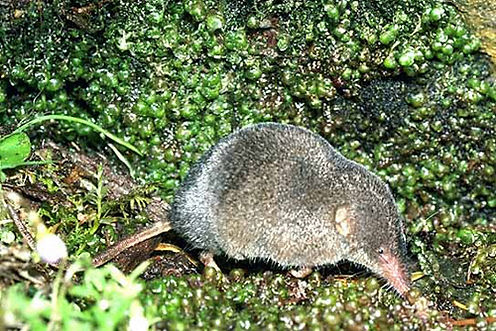smoky shrew (Sorex fumeus fumeus)
CONFIRMATION STATUS: Not confirmed.
CHARACTERISTICS: The native smoky shrew is the second largest
eastern longtailed shrew weighing on average 7.7 grams and with a total
average length of 116.8 mm. In appearance, they are found to be a dark
grey in winter and a olive-brown in summer, with paler underparts, and
a bicolored tail. Between March and early October, two sometimes three
litters are born of 2-10 young. The young are full grown and independent
at the end of four weeks. This species builds its own burrows or uses those
of other small animals through damp leaf mold. The nest is made of dry
vegetation in stumps, logs, and among rocks. It is suspected that few live
more than 1 year in the wild. This species is preyed on by shorttailed
shrews, weasels, foxes, bobcats, owls, hawks and other predators.
DISTRIBUTION: This species is found in the western and northern
part of state. It has the greatest geographical and altitudinal range of
all Virginia's montane forms. The preferred habitat is damp deciduous-
coniferous forest around stumps and under mossy logs near streams and
the species appears to be confined to mountains. They were captured at
elevations ranging from 700-4000 feet with a mean of 2200 feet.
FOODS: The smoky shrew eats mainly insects and invertebrates living in
the leaf litter, which includes centipedes and earthworms . They have also
been known to eat salamanders.

Park Activities
Calendar of Events
Volunteer Programs
Sky Meadows Park
Location
Geography
Habitats
Trails
Visiting Park
Crooked Run Valley
Special Projects

